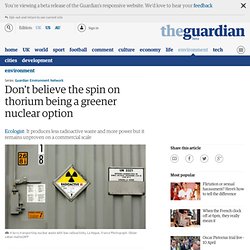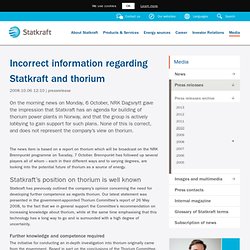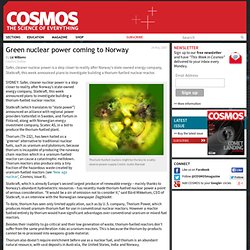

A Nuclear Reactor in Every Home. Sometime between 2020 and 2040, we will invent a practically unlimited energy source that will solve the global energy crisis. Alternative for nuclear power generation? The world's growing need for energy, the limits of our supply of fossil fuels and concern about the effects of carbon emissions on the environment have all prompted interest in the increased use of nuclear power.

Yet the very word "nuclear" carries with it an association of fear. People are concerned about the waste produced by reactors, the possibility of catastrophic accidents as highlighted by recent events in Japan and the link between nuclear power and nuclear weapons. Energy from Thorium. Thorium fuel cycle.
The thorium fuel cycle is a nuclear fuel cycle that uses the naturally abundant isotope of thorium, 232Th, as the fertile material.

In the reactor, 232Th is transmuted into the fissile artificial uranium isotope 233U which is the nuclear fuel. Unlike natural uranium, natural thorium contains only trace amounts of fissile material (such as 231Th), which are insufficient to initiate a nuclear chain reaction. Additional fissile material or another neutron source are necessary to initiate the fuel cycle. In a thorium-fueled reactor, 232Th absorbs neutrons eventually to produce 233U. This parallels the process in uranium breeder reactors whereby fertile 238U absorbs neutrons to form fissile 239Pu. Thorium. (Updated March 2014) Thorium is more abundant in nature than uranium.It is fertile rather than fissile, and can only be used as a fuel in conjunction with a fissile material such as recycled plutonium.Thorium fuels can breed fissile uranium-233 to be used in various kinds of nuclear reactors.Molten salt reactors are well suited to thorium fuel, as normal fuel fabrication is avoided.

The use of thorium as a new primary energy source has been a tantalizing prospect for many years. Extracting its latent energy value in a cost-effective manner remains a challenge, and will require considerable R&D investment. This is occurring preeminently in China, with modest US support. New age nuclear. Credit: Justin Randall What if we could build a nuclear reactor that offered no possibility of a meltdown, generated its power inexpensively, created no weapons-grade by-products, and burnt up existing high-level waste as well as old nuclear weapon stockpiles?

And what if the waste produced by such a reactor was radioactive for a mere few hundred years rather than tens of thousands? It may sound too good to be true, but such a reactor is indeed possible, and a number of teams around the world are now working to make it a reality. What makes this incredible reactor so different is its fuel source: thorium. Named after Thor, the warlike Norse god of thunder, thorium could ironically prove a potent instrument of peace as well as a tool to soothe the world’s changing climate. Could thorium make nuclear power safe. Don't believe the spin on thorium being a greener nuclear option. In a world increasingly aware of and affected by global warming, the news that 2010 was a record year for greenhouse gases levels was something of a blow.

With the world's population due to hit nine billion by 2050, it highlights the increasingly urgent need to find a clean, reliable and renewable source of energy. India hopes it has the answer: thorium, a naturally occurring radioactive element, four times more abundant than uranium in the earth's crust. The pro-thorium lobby claim a single tonne of thorium burned in a molten salt reactor (MSR) – typically a liquid fluoride thorium reactor (LFTR) – which has liquid rather than solid fuel, can produce one gigawatt of energy. A traditional pressurised water reactor (PWR) would need to burn 250 tonnes of uranium to produce the same amount of energy.
They also produce less waste, have no weapons-grade by-products, can consume legacy plutonium stockpiles and are meltdown-proof – if the hype is to be believed. Incorrect information regarding Statkraft and thorium - Statkraft. On the morning news on Monday, 6 October, NRK Dagsnytt gave the impression that Statkraft has an agenda for building of thorium power plants in Norway, and that the group is actively lobbying to gain support for such plans.

None of this is correct, and does not represent the company’s view on thorium. The news item is based on a report on thorium which will be broadcast on the NRK Brennpunkt programme on Tuesday, 7 October. Brennpunkt has followed up several players all of whom – each in their different ways and to varying degrees, are looking into the potential future of thorium as a source of energy. Statkraft has previously outlined the company’s opinion concerning the need for developing further competence as regards thorium.
Green nuclear power coming to Norway. Thorium-fuelled reactors might be the key to a safer, cleaner power supply Credit: Justin Randall SYDNEY: Safer, cleaner nuclear power is a step closer to reality after Norway’s state-owned energy company, Statkraft, this week announced plans to investigate building a thorium-fuelled nuclear reactor.

Statkraft (which translates to “state power”) announced an alliance with regional power providers Vattenfall in Sweden, and Fortum in Finland, along with Norwegian energy investment company, Scatec AS, in a bid to produce the thorium-fuelled plant. Thorium (Th-232), has been hailed as a ‘greener’ alternative to traditional nuclear fuels, such as uranium and plutonium, because thorium is incapable of producing the runaway chain reaction which in a uranium-fuelled reactor can cause a catastrophic meltdown.
“Green Nukes” An Important Climate Change Mitigation Tool. Adam Curry interviewed Curt Stager, the author of Deep Future: The Next 100 Years of Life on Earth for his Big Book Show.

During the interview, Curry and Stager spent several minutes discussing the potential for “green nukes” to be an important climate change mitigation tool. Aside: Adam Curry interviewed me four years ago about Adams Engines; he has been interested in new nuclear power plants for a long time. End Aside. There are many terrific reasons to favor the rapid development of nuclear fission technology. For some odd reason, possibly having to do with certain brands of political ideology, many nuclear professionals are reluctant to emphasize that last feature. Safe nuclear does exist, and China is leading the way with thorium. “If it begins to overheat, a little plug melts and the salts drain into a pan.

There is no need for computers, or the sort of electrical pumps that were crippled by the tsunami. The reactor saves itself,” he said. “They operate at atmospheric pressure so you don’t have the sort of hydrogen explosions we’ve seen in Japan. One of these reactors would have come through the tsunami just fine. There would have been no radiation release.” China blazes trail for 'clean' nuclear power from thorium. UK Report Finds Benefits of Thorium Fission “Overstated” “Thorium has theoretical advantages regarding sustainability, reducing radiotoxicity and reducing proliferation risk,” states the report, prepared for the Department of Energy and Climate Change by the National Nuclear Laboratory (NNL).

NNL remains pessimistic, mostly because UK utility companies aren’t willing to invest the money to fully investigate thorium’s supposed benefits, but will probably continue to spend some resources continuing development of the fuel. The UK Atomic Energy Authority [AEA] built an experimental thorium-fueled reactor in the 60′s, but it’s mostly decommissioned right now.
Flibe Energy in the US is building a reactor based on designs developed by the US Department of Energy’s Oak Ridge National Laboratory in the 1960′s. Norway ringing in thorium nuclear New Year. SHANGHAI - A privately held Norwegian company will start burning thorium fuel in a conventional test reactor owned by Norway's government with help from U.S. -based nuclear giant Westinghouse, the company revealed here recently. The four-year test at Norway's government owned Halden reactor could help thorium inch closer to replacing uranium as a possible safer and more effective nuclear power source. Many people believe that thorium is superior because it leaves less long- lived dangerous waste, makes it far more difficult to fashion bombs, runs more efficiently, and can be made meltdown proof. Oslo-based Thor Energy will deploy a mix of solid thorium mixed with plutonium - a blend known as "thorium MOX" - Thor's chief technology officer Julian Kelly told the Thorium Energy Conference 2012.
Thorium-Fueled Automobile. By: David Russell Schilling | October 28th, 2013 Thorium Concept Car - Image Courtesy www.greenpacks.com There are now over one billion cars traveling roads around the world directly and indirectly costing trillions of dollars in material resources, time and noxious emissions. Imagine all these cars running cleanly for 100 years on just 8 grams of fuel each. Laser Power Systems (LPS) from Connecticut, USA, is developing a new method of automotive propulsion with one of the most dense materials known in nature: thorium.
Because thorium is so dense it has the potential to produce tremendous amounts of heat. Cadillac World Thorium Fuel Concept (Image Courtesy www.cutedesign.com) Current models of the engine weigh 500 pounds, easily fitting into the engine area of a conventionally-designed vehicle. The idea of using thorium is not new. According to Robert Hargraves, “low or non-CO2 emitting energy sources must be cheaper than coal or will ultimately fail to displace fossil fuels.” Is Thorium the Future of Nuclear Power. So following the near meltdown of several reactors at Fukushima Nuclear Power, it’s dead is it? Well, to follow one FT article, you could be mistaken for thinking that will be the likely outcome. As the article reports, impact on the industry has been dramatic, from miners like Cameco, a major Canadian uranium producer, whose share price has fallen 20 percent since March 10th, to major deals like Russian ARMZ’s acquisition of Mantra Resources for A$1.2 billion that has been called off after the buyer’s (an ARMZ subsidiary Uranium One) share price fell 34 percent.
Apparently by the end of last week, the (admittedly thinly traded) spot uranium price had fallen 27 percent since Friday to $50/lb. More importantly for nuclear power, it is not the markets that have been spooked but public opinion and the governments that react to that opinion – at least in democracies. Select the reports you are interested in:NO-SPAM: Under no circumstances will we EVER rent, sell or give away your email By.